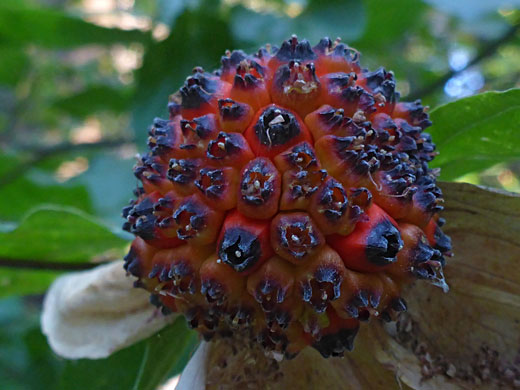Common names:
Pacific dogwood, western dogwood
Family:
Scientific name:
Cornus nuttallii
Main flower color:
Range:
The Pacific states, and small areas of Idaho
Height:
Up to 70 feet
Habitat:
Woodland, from sea level to 7,000 feet, sometimes higher
Leaves:
Opposite, elliptic to obovate or ovate, up to 4.5 inches long, on stalks of up to 0.4 inches
Season:
to
Cornus nuttallii is a small to medium-sized tree, up to 70 feet tall, found in a variety of wooded habitats, from sea level to mountains. Young branches are greenish and hairy; when older the bark becomes dark red to black. The unlobed leaves are bright green above, with a sparse covering of short, appressed hairs, paler green, and more hairy below.
The inflorescence is a compact, domed cluster, subtended by four to seven bracts, white, withering to brown, crossed by greenish veins. Bracts are widely ovate to nearly round, up to 2.3 inches long and wide, resembling petals. Individual flowers are small, less than a quarter of an inch across, with four white or pale green petals. Stamens are exserted. Fruits are bright red, tightly clustered
The inflorescence is a compact, domed cluster, subtended by four to seven bracts, white, withering to brown, crossed by greenish veins. Bracts are widely ovate to nearly round, up to 2.3 inches long and wide, resembling petals. Individual flowers are small, less than a quarter of an inch across, with four white or pale green petals. Stamens are exserted. Fruits are bright red, tightly clustered
All Contents © Copyright The American Southwest | Comments and Questions | Contribute | Site Map



